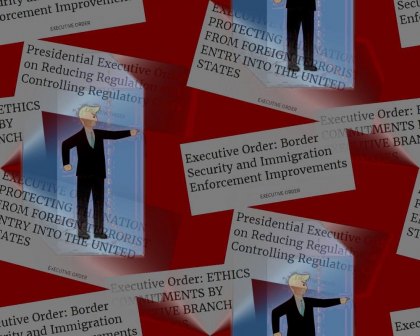
Since taking office, he has signed seven executive orders, including one taking aim at the Affordable Care Act, another calling for a wall between the U.S. and Mexico and an order restricting immigration from seven countries with Muslim majorities.
But what are executive orders and how common is it for presidents to use them? Here are some questions and answers, along with links for further study:
What are executive orders? Executive orders from a president are “generally directed to, and govern actions by, government officials and agencies,” according to a research paper by the House Committee on Government Operations, Executive Orders and Proclamations: A Study of a Use of Presidential Powers (1957).
There is no definition of executive orders, presidential memorandums or proclamations in the U.S. Constitution. "As such, authority for the execution and implementation of these written instruments stems from implied constitutional and statutory authority," explains a paper by the Congressional Research Service. "In the constitutional context, presidential power is derived from Article II of the U.S. Constitution, which states that 'the executive power shall be vested in a president of the United States,' that 'the president shall be commander in chief of the Army and Navy of the United States,' and that the president 'shall take care that the laws be faithfully executed.' The president’s power to issue these directives may also derive from express or implied statutory authority."
Executive orders have "the force of law but do not have to be approved by congress,” explains the article, Executive Powers, on Cornell University Law School’s Legal Information Institute website.
Some executive orders are numbered, and others aren’t. What’s up with that? Numbering the orders began in 1907 “by the Department of State, which assigned numbers to all the orders then in their files dating from 1862,” recounts the American Presidency Project’s website. More documentation occurred as a result of the Federal Register Act in 1936.
How are executive orders different from memorandums and proclamations? Other than issuing executive orders, presidents also use memorandums and proclamations to achieve policy goals. Trump has signed 11 memorandums and one proclamation since taking office."It seems that Presidents are more apt to utilize executive orders on matters that may benefit from public awareness or be subject to heightened scrutiny," the Congressional Research Service explains. "Memoranda, on the other hand, are often used to carry out routine executive decisions and determinations, or to direct agencies to perform duties consistent with the law or implement laws that are presidential priorities."
Proclamations affect the activities of private citizens. But as explained in the U.S. House Committee paper: “Since the president has no power or authority over individual citizens and their rights except where he is granted such power and authority by a provision in the Constitution or by statute, the president’s proclamations are not legally binding and are at best hortatory unless based on such grants of authority.”
Do the president's powers change in times of war or emergency? The president's powers increase. Indeed, in an emergency the president can “override congress and issue executive orders with almost limitless power,” explains the Cornell University Law School website. “Abraham Lincoln used an executive order in order to fight the Civil War, Woodrow Wilson issued one in order to arm the United States just before it entered World War I, and Franklin Roosevelt approved Japanese internment camps during World War II with an executive order. Many other executive orders are on file and could be enacted at any time.”
Which president signed the most executive orders? An article in our resources section has a chart listing executive orders by president using numbers from the American Presidency Project. Franklin Delano Roosevelt signed the most, on average 307 executive orders per year during the 12 years of his presidency.
William Henry Harrison, who died a month after taking office, is the only president listed as signing no executive orders. George Washington signed eight -- an average of one per year.
Among the more recent presidents, George W. Bush issued an average of 36 per year; Barack Obama issued 35 per year. Bush’s father,George H.W. Bush, issued an average of 42 per year during his one term in office. Bill Clinton, who served two terms, signed an average of 46 per year.
To know more:
- The American Presidency Project, University of California, Santa Barbara: Executive orders.
- Congressional Research Service, Executive orders: Issuance, Modification and Revocation, by Vivian S. Chu and Todd Garvey (2014).
- Cornell University’s Legal Information Institution: Executive Powers.
- Villanova University School of Law: Executive Orders and the Development of Presidential Power, by William Hebe, (1972).
- U.S. House Committee on Government Operations, Executive Orders and Proclamations: A Study of a Use of Presidential Powers (1957).
- White House: Executive orders.
Related:
Resources: Executive orders by the numbers
Trump’s firing evokes Nixon case
Follow StudyHall.Rocks on Twitter.
If you would like to comment, give us a shout, or like us on Facebook and tell us what you think.